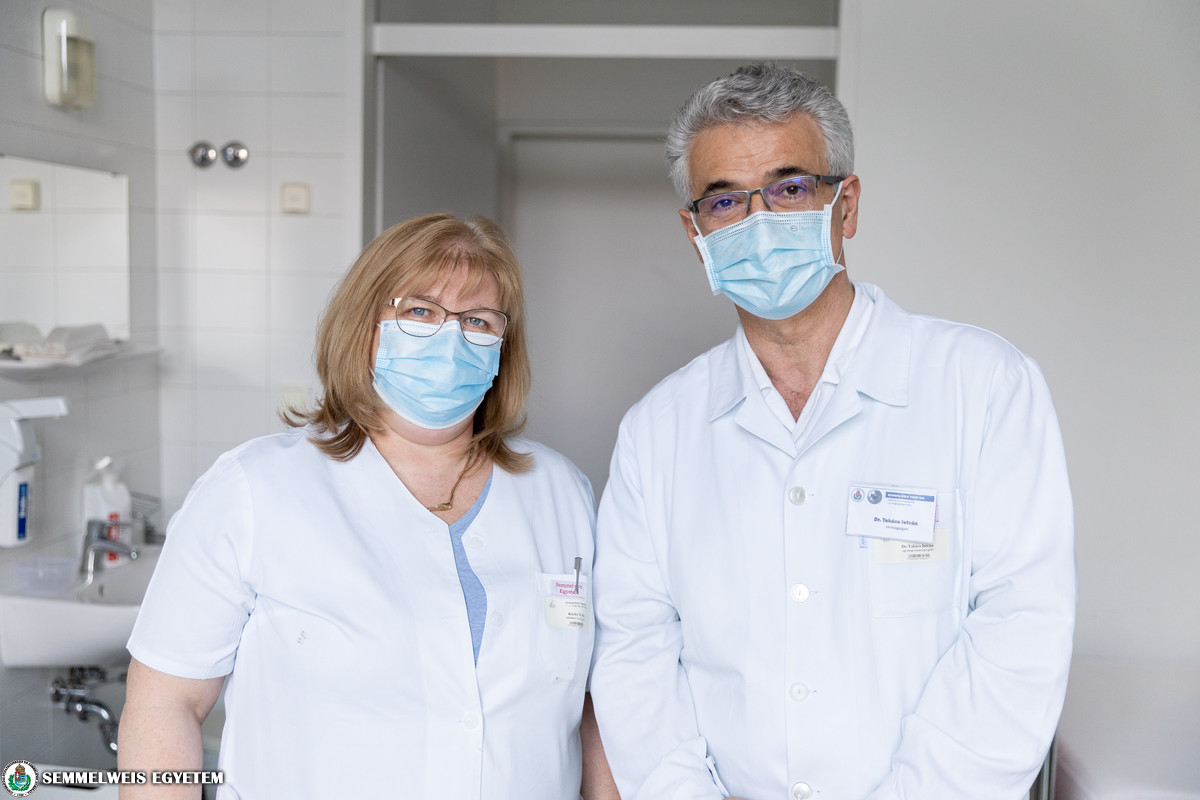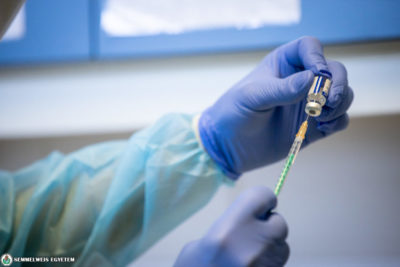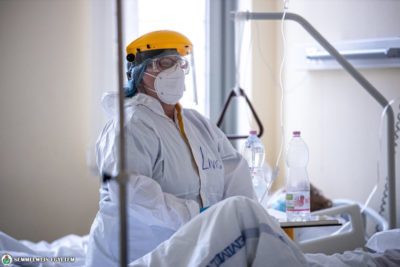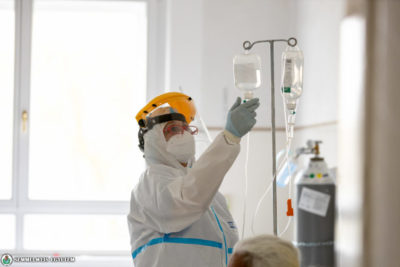The Department of Internal Medicine and Oncology was involved in COVID care from the first moment of the outbreak of the epidemic at three sites. Meanwhile, the safe care of oncology patients was also ongoing. We asked Dr. István Takács, Director and Csilla Kiefer, Head Nurse about their experiences as part of our series of articles introducing organizational units involved in COVID care.
“One of the most important experiences is the fact how well colleagues coped with the situation, even under the extreme workload”
Dr. István Takács, Director, Department of Internal Medicine and Oncology
How long have you been involved in COVID patient care?
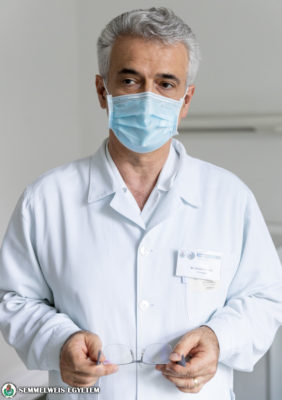 We were involved in COVID patient care right from the first moment of the first wave of the epidemic. At the peak of the third wave, we cared for 204 COVID inpatients at the same time, which means that almost the entire clinic was involved in the care of patients infected by coronavirus at three different sites: in the Epidemic Block on Tömő utca, at the Department of Urology and in our own clinical building. As regards our building site in Tömő utca, we provided care on the 5th floor, and it is still one of the departments within the university that we will maintain in cooperation with the Department of Internal Medicine and Hematology in case the number of cases increases again. Therefore, we are still on alert in that respect. I find it important to highlight that the oncology profile, in addition to all this, worked continuously in changing, but always COVID-free settings for the sake of patient safety.
We were involved in COVID patient care right from the first moment of the first wave of the epidemic. At the peak of the third wave, we cared for 204 COVID inpatients at the same time, which means that almost the entire clinic was involved in the care of patients infected by coronavirus at three different sites: in the Epidemic Block on Tömő utca, at the Department of Urology and in our own clinical building. As regards our building site in Tömő utca, we provided care on the 5th floor, and it is still one of the departments within the university that we will maintain in cooperation with the Department of Internal Medicine and Hematology in case the number of cases increases again. Therefore, we are still on alert in that respect. I find it important to highlight that the oncology profile, in addition to all this, worked continuously in changing, but always COVID-free settings for the sake of patient safety.
What is the role of your unit in COVID-19 patient care?
Our special task was to care for hematology and nephrology patients, including those treated with a dialysis. Both patient groups are particularly at risk, because the underlying disease weakens their immune systems anyway. Within the framework of profession-specific care, we also treated patients with diabetes and people with high blood pressure; these two diseases are also major risk factors for COVID-related mortality. Despite all this, we participated in COVID patient care with very good results. A high-level nursing work has played a key role in this, and also the fact that we have continuously followed the latest results on COVID care protocols in general care and in the special patient groups we have treated. It also mattered a great deal that all the tools and medicines were available to us thanks to the university.
To what extent did you have to reorganize work?
Essentially, our clinic has 130 hospital beds, but during the epidemic we had to work with an almost 60% increase of the number of inpatients in three locations, for which we received a lot of support: our team was supplemented by physicians and nurses with the central support of the university. Many thanks to the staff members who were commanded to us and worked with a high standard and dedication. However, since we provided care at three different sites, we had to ensure three on-call teams instead of the usual one, and in order to achieve this, all staff members took on on-call duties without exception, and we also maintained education in the meantime. Our entire team did their best in order to be able to face the challenges.
What differences do you see between the first, the second and the third waves of the epidemic at the department?
Retrospectively, I consider the first wave as sort of a warm-up of the situation. Even in the second wave, we did not have to use all of our resources, although we have already opened the COVID unit at the Department of Urology and on the 5th floor of the Tömő utca Epidemic Block. In the third wave, however, in addition to these, we already provided COVID care with full capacity at the premises of our own department.
What are the most important lessons and experiences that will be useful in the future?
One of the most important experiences is the fact how well colleagues coped with the situation, even under the extreme workload. Everyone took on the increased amount of on-call duties together with the larger amount of workload, without hesitation. We were able to perform treatments at a high level, and in the meantime we also focused on education and research. At the beginning of the third wave, we began to conduct a survey about what factors influence the severity of the course of the disease and what risk factors may lead to death. Data from more than 900 patients have been collected for this study and are currently being processed.
“This challenge showed that we are able to fight anything as a team”
Csilla Kiefer, Head Nurse, Department of Internal Medicine and Oncology
In terms of professional and nursing responsibilities, what is the biggest change that the coronavirus has brought?
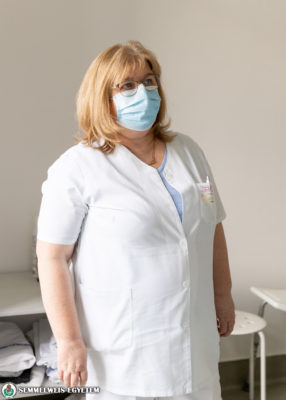 The healthcare professionals have already played a very important role in the tasks related to architecture carried out in the framework of the preparations, since transformations were needed in order to make our internal medicine department and wards epidemiologically suitable for COVID care. A safety entry system had to be created, a camera system had to be set up so that we could continuously monitor the patient’s condition from outside the red zone, too. The oxygen supply had to be reorganized and the central oxygen supply had to be built up. The nursing spaces also had to be adapted to the new situation. Since we could not take anything outside of the red zone, we had to make everything available locally: the infusion set, equipment for blood taking and other supplies that previously we had always stored and prepared in the nurse’s room so far. We had to deal with the communication process between the red and green zones, which was helped a great deal by the walkie talkies, but we also learned how the window glass may help to convey the information in the patient documentation, since we could not remove the papers from inside the infectious zone. COVID care requires a larger number of nurses than our original profile, so it was a great help that nurses as well as medical and nursing students assisted us from other departments of the university. It meant a great deal that the assistants in our outpatient clinics, who otherwise are not involved in direct patient care, came to help us without hesitation.
The healthcare professionals have already played a very important role in the tasks related to architecture carried out in the framework of the preparations, since transformations were needed in order to make our internal medicine department and wards epidemiologically suitable for COVID care. A safety entry system had to be created, a camera system had to be set up so that we could continuously monitor the patient’s condition from outside the red zone, too. The oxygen supply had to be reorganized and the central oxygen supply had to be built up. The nursing spaces also had to be adapted to the new situation. Since we could not take anything outside of the red zone, we had to make everything available locally: the infusion set, equipment for blood taking and other supplies that previously we had always stored and prepared in the nurse’s room so far. We had to deal with the communication process between the red and green zones, which was helped a great deal by the walkie talkies, but we also learned how the window glass may help to convey the information in the patient documentation, since we could not remove the papers from inside the infectious zone. COVID care requires a larger number of nurses than our original profile, so it was a great help that nurses as well as medical and nursing students assisted us from other departments of the university. It meant a great deal that the assistants in our outpatient clinics, who otherwise are not involved in direct patient care, came to help us without hesitation.
To what extent do these patients require special nursing care?
The basic tasks, such as blood taking, infusion, drug therapy, helping the patients with eating and sitting up if necessary are the same, only the circumstances have changed completely, which had an effect on everything. It was fantastic to experience how our nurses were able to overcome their own fears or difficulties caused by protective clothing. It is a huge challenge, for example, to take blood through multi-layered rubber gloves, to stab a vein, but still everyone got used to the new situation rapidly.
How does the protective equipment change processes and the way you connect with patients?
One of the largest difficulties was communicating with patients, especially with older patients who had problems related to hearing. We had to speak louder and articulate more, yet it was still important that our presence, along with this and the faceless protective clothing remain reassuring, as being isolated and missing their relatives meant a severe mental burden to the patients.
What are the most important lessons and experiences that will be useful in the future?
The experience we have gained in caring for infectious patients is already ours. Ignác Semmelweis, the namesake of our university, “invented” hand washing for almost half a century ago, but I think this year we have come to the point where the entire world has learned the name of Semmelweis and mastered hygienic hand disinfection to a perfect level. The only other positive benefit of the recent period is that this challenge has shown that we are not alone and can fight anything in a team. With the redeployment, people working in different departments got to know each other better, and now we can think together not only as a clinical but also as a university family. We were together at the outbreak of the epidemic and we all fought for one thing, about which everyone knew that it could only be solved together, in cooperation. We received a lot of help from each other and from the management as well. I am extremely proud to have worked with such a team and that we have been able to go through this difficult period.
Pálma Dobozi
Photo: Attila Kovács – Semmelweis University; the featured image is illustration
Translation: Katalin Illés-Romhányi
